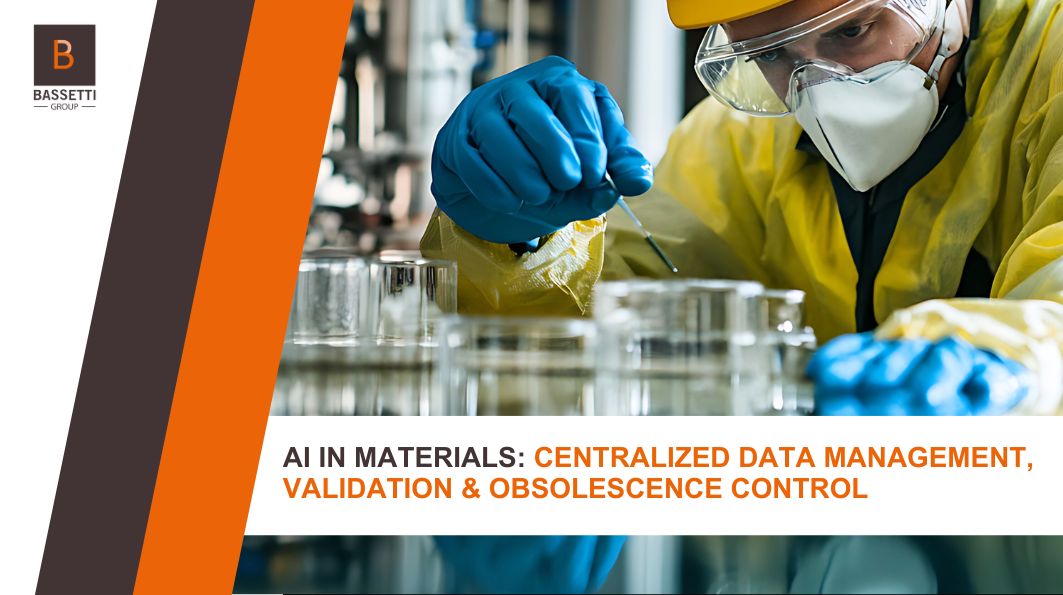AI in Materials: Centralized Data Management, Validation & Obsolescence Control
Artificial Intelligence is fundamentally reshaping materials engineering, enabling the centralized management of complex material data and unlocking predictive insights across the entire lifecycle.
By consolidating testing results, multiphysical characteristics, usage histories, and provenance traceability on a single platform, AI establishes a foundation of reliability and transparency. This convergence not only optimizes materials selection but also validates data quality continuously, anticipates obsolescence, and empowers engineers to make high-value, informed decisions efficiently.

Digital Transformation in Materials Engineering
Industry 5.0 and the Human-Technology Synergy
The materials sector is entering an era defined by Industry 5.0, where digital transformation goes beyond automation. It integrates advanced technologies with human expertise, prioritizing sustainability and performance. Methodologies such as Integrated Computational Materials Engineering (ICME) and initiatives like the Materials Genome Initiative (MGI) combine simulations, experimental data, and collaborative platforms to accelerate materials discovery, design, and optimization.
These frameworks ensure a seamless connection between numerical simulations, experimental results, and industrial workflows, all while minimizing ecological impact and maximizing material functionality. The objective is clear: to create a unified cyberinfrastructure adhering to FAIR principles (Findable, Accessible, Interoperable, Reusable), while incorporating circularity and resilience into materials management.
A Collaborative Digital Ecosystem
A modern materials digital ecosystem integrates:
- Advanced modeling tools (thermodynamics, mechanics, microstructure)
- Experimental databases from laboratories and industry
- Collaborative platforms that support cross-functional decision-making
This approach ensures information flows seamlessly from concept to industrialization, positioning human judgment and sustainability at the center of material choices. AI emerges in this environment as a strategic catalyst, centralizing data, revealing hidden correlations, and enabling predictive analytics that enhance every stage of the materials lifecycle.
Challenges in Materials Data Management
Data Complexity and Volume
One of the greatest hurdles in digital materials management is the exponential growth and complexity of data. Every stage—from research and development to industrial production—generates vast amounts of information, including:
- Experimental lab tests and measurements
- Advanced numerical simulations (e.g., Density Functional Theory, CALPHAD)
- Multiphyiscal properties (mechanical, thermal, optical, vibrational, chemical)
The diversity of data formats—from PDFs and CSVs to proprietary databases and sensor outputs—creates fragmentation that is difficult to manage manually. This slows analysis, increases errors, and limits scalability.
Solution: Implementing centralized materials data platforms that standardize, index, and integrate heterogeneous datasets is essential. These platforms must support native compatibility with business tools (CAD, LIMS, ERP, MES) and provide fast access to relevant information regardless of origin.
Data Quality and Obsolescence
Collecting data is not sufficient; its quality and freshness are crucial. Obsolete or inconsistent data can compromise AI models, leading to design errors or unsuitable material choices. To ensure reliability, platforms must integrate:
- Real-time validation mechanisms
- Automatic detection of inconsistencies
- Gap identification and anomaly alerts
Centralized, auditable, and up-to-date databases turn data into a strategic asset. By ensuring dynamic obsolescence management, companies reduce risks, strengthen industrial decisions, and maintain robust digital continuity across the materials lifecycle.
Artificial Intelligence as a Driver of Innovation
Predictive Insights and Materials Performance
AI, particularly machine learning, is transforming traditional R&D approaches in materials engineering. Sequential experimentation, previously limited by cost and time, is now augmented by AI’s ability to analyze large datasets, identify complex correlations, and predict material performance without exhaustive physical testing.
Predictive AI evaluates materials based on:
- Technical performance
- Economic viability
- Environmental impact
Platforms like TEEXMA exemplify this approach, combining structured databases with AI-driven analytics to accelerate the discovery of innovative alloys and reduce development costs and timelines.
From Prediction to Intelligent Data Structuring
AI not only predicts properties but also automates data structuring and traceability:
- Detects incomplete, inconsistent, or obsolete information
- Implements dynamic validation and automated alerts
- Structures and visualizes material information for R&D, quality, and industrialization teams
Interactive dashboards, dynamic performance maps, and visualization tools allow engineers to:
- Rapidly explore trends and correlations
- Identify optimal materials for specific project criteria
- Collaborate efficiently across functional teams
In essence, AI converts heterogeneous materials data into actionable digital capital, enhancing decision-making throughout the lifecycle.
Use Cases and Industrial Success
Aerospace, Automotive, and Renewable Energy
In high-tech industries, AI integration within the materials lifecycle delivers measurable results:
- Time-to-market reduction: AI reduces R&D timelines by up to 50% and lowers costs by 30%, according to PwC.
- Optimized formulations: Predictive analytics and digital twins simulate performance before physical testing, reducing reliance on costly prototypes.
- Operational efficiency gains: Digital twin simulations enable top-performing companies to achieve up to 15% efficiency improvements (Capgemini Research Institute).
Virtual Testing and Predictive Design
Digital twins replace a significant portion of physical prototypes with high-fidelity virtual simulations. This approach allows:
- Testing of scenarios inaccessible or costly in real-world conditions
- Enhanced robustness in regulated sectors (aerospace, automotive)
- Better management of technical and regulatory risks via predictive design and compliance simulations
As Michael Grieves notes, virtual testing enables more extensive simulations while maintaining reliability equivalent to physical testing. AI thus becomes a strategic lever, facilitating faster market launches of innovative materials while meeting stringent environmental and regulatory standards.
Limits and Perspectives
Data Standardization and Quality
AI’s effectiveness in materials engineering is contingent upon high-quality, consistent, and traceable data. In practice, data originates from a mosaic of experimental tests, simulations, and real-world measurements, often in heterogeneous formats without consistent metadata.
Solutions include:
- Shared standards (common semantics, units, documentation)
- Adoption of ICME and FAIR principles for interoperability
- Rigorous validation protocols and persistent digital identifiers (DOI, UUID)
These measures ensure auditable, transparent, and reusable data, fostering confidence among engineers and industrial decision-makers.
Integration into Industrial Systems
An AI platform for materials cannot operate in isolation. Integration with existing systems (ERP, MES, PLM) is critical to prevent data silos and ensure continuity from design to service monitoring.
Connected systems allow AI to:
- Update bills of materials automatically
- Detect non-conformities in real time
- Adjust production parameters dynamically
This creates a coherent, scalable, and responsive digital ecosystem, augmented by human expertise. Targeted training, digital literacy, and change management remain essential for effective adoption.
Human-AI Collaboration and Explainability
In materials engineering, where safety and performance are paramount, explainable AI (XAI) is vital. Accurate predictions are insufficient; engineers must understand and validate AI outputs.
XAI provides:
- Confidence indicators and sensitivity maps
- Readable algorithmic justifications
- Support for predictive maintenance using sensor data
By combining AI’s computational power with human judgment, organizations create hybrid systems that are safer, more reliable, and resilient under uncertainty.
Towards Intelligent and Sustainable Materials Management
Unified, AI-driven management of materials data enables:
- Faster and more precise materials selection
- Continuous validation of data quality
- Proactive obsolescence management
Engineers regain a central role, supported by accurate information for sustainable, responsible decision-making. Platforms like TEEXMA for Materials demonstrate how AI can structure materials data, accelerate discovery, and maintain digital continuity, outlining a future where data becomes a strategic asset in a more agile, efficient, and environmentally conscious materials industry.
